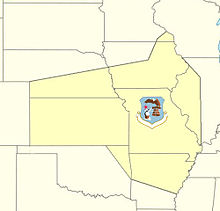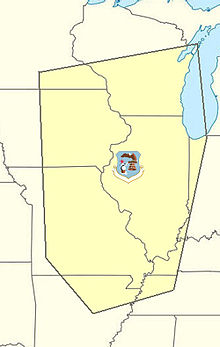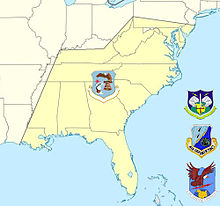20th Air Division
20th Air Division
 File:Tacemblem.jpg File:Tacemblem.jpg | |
|---|---|
 | |
| Active | 1955–1960; 1966–1967; 1969–1983 |
| Country | |
| Branch | |
| Role | Command of air defense forces |
| Part of | Tactical Air Command |
| Insignia | |
| 20th Air Division Emblem (approved 20 August 1956)[1] |  |

The 20th Air Division is an inactive United States Air Force organization. Its last assignment was with Tactical Air Command at Tyndall Air Force Base, Florida where it was inactivated on 1 March 1983.
During most of the division's history it served with Air Defense Command as a regional command and control headquarters. Between 1955 and 1967 the division controlled air defense units in the central United States. It controlled a slightly different areas of the midwestern US from 1955 to 1960 and again from 1966 to 1967. Its area of responsibility shifted to the east coast if the United States from 1969 to 1983. It was shifted to its final station on paper in 1983 and was immediately inactivated.
History
The 20th Air Division was assigned to Air Defense Command (ADC) for most of its existence. It served as a regional command and control headquarters, controlling fighter interceptor and radar units over several areas of responsibility during the Cold War. For three years it also commanded a surface-to-air missile squadron.[1]
The division was initially activated as an intermediate command organization under Central Air Defense Force at Grandview Air Force Base (later Richards-Gebaur Air Force Base) in June 1955.[2] The division was responsible for the interceptor and radar units within an area that covered parts of Nebraska, Oklahoma, Arkansas, Illinois, Iowa, and virtually all of Kansas and Missouri.[3]
On 1 October 1959 ADC activated the Sioux City Air Defense Sector and its Semi Automatic Ground Environment (SAGE) DC-22 Direction Center and assigned it to the division.[4] The 20th also operated a Manual Control Center (MCC-2) at Richards-Gebaur. The division was inactivated in 1960 when ADC reorganized its regional air defense units, and the 33d Air Division assumed command of most of its former units.[2][5]

The division was reactivated in 1966 under Tenth Air Force as a SAGE organization, replacing the Chicago Air Defense Sector when ADC discontinued its air defense sectors and replaced them with air divisions.[6] The 20th provided air defense from the Truax Field, Wisconsin DC-7/CC-2 SAGE blockhouse for parts of Wisconsin, Minnesota, Iowa, Missouri, Arkansas, Tennessee, Kentucky, Indiana, and all of Illinois.[3] The division also acted as the 20th NORAD Region after activation of the North American Air Defense Command (NORAD) Combat Operations Center at the Cheyenne Mountain Complex, Colorado. Operational control of the division was transferred to NORAD from ADC.[citation needed]
In addition to the active duty interceptor and radar units, the division supervised Air National Guard units that flew interception sorties using (among other aircraft) McDonnell F-101 Voodoos and Convair F-106 Delta Darts. At the same time the division controlled numerous radar squadrons. It was inactivated in 1967[1] as part of an ADC consolidation of intermediate level command and control organizations, driven by budget reductions required to fund USAF operations in Southeast Asia.[citation needed]

The 20th Air Division was activated for a third time in November 1969 under Aerospace Defense Command (ADCOM).[2] The division provided air defense for virtually all of the southeastern United States, except for most of Louisiana from the SAGE DC-4 blockhouse at Fort Lee Air Force Station, Virginia.[7] The division also controlled a CIM-10 Bomarc surface-to-air anti-aircraft missile squadron near Langley Air Force Base until the squadron's inactivation in October 1972.[8]
ADCOM was inactivated on 1 October 1979. The atmospheric defense resources (interceptors and warning radars) of ADCOM were reassigned to Tactical Air Command, which formed Air Defense, Tactical Air Command as the headquarters to control them.[9] After 1981, the division controlled units equipped with McDonnell Douglas F-15 Eagle aircraft. Its subordinate units continued to participate in intensive academic training, numerous multi-region simulated (non-flying) exercises, and flying exercises.[1]
The division moved to Tyndall Air Force Base, Florida in March 1983[1] where it was inactivated and its mission, personnel and equipment were transferred to the Southeast Air Defense Sector.[10]
Lineage
- Established as the 20 Air Division (Defense) on 8 June 1955
- Activated on 8 October 1955
- Inactivated on 1 January 1960
- Activated on 20 January 1966 (not organized)
- Organized on 1 April 1966
- Discontinued and inactivated, on 31 December 1967
- Activated on 19 November 1969
- Inactivated on 1 March 1983[11]
Assignments
- Central Air Defense Force, 8 October 1955 – 1 January 1960
- Air Defense Command, 20 January 1966
- Tenth Air Force, 1 April 1966 – 31 December 1967
- Aerospace Defense Command, 19 November 1969
- Air Defense, Tactical Air Command, 1 October 1979 – 1 March 1983[11]
Stations
- Grandview Air Force Base (later, Richards Gebaur Air Force Base0, Missouri, 8 October 1955 – 1 January 1960
- Truax Field, Wisconsin, 1 April 1966 – 31 December 1967
- Fort Lee Air Force Station, Virginia, 19 November 1969
- Tyndall Air Force Base, Florida, 1 March 1983 – 1 March 1983[11]
Components
Sector
- Sioux City Air Defense Sector: 1 October 1959 – 1 January 1960[4]
Groups
- 53d Fighter Group: 1 March 1956 – 1 January 1960[12]
- Sioux Gateway Airport, Iowa
- 327th Fighter Group: 1 April 19–25 April June 1966[13]
- Truax Field, Wisconsin
- 328th Fighter Group: 1 March 1956 – 1 January 1960[14]
- Richards-Gebaur Air Force Base, Missouri
- 678th Air Defense Group: 1 March 1970 – 1 March 1983[15]
- Tyndall Air Force Base, Florida[16]
- 701st Air Defense Group: 1 March 1970 – 17 January 1974[17]
- Fort Fisher Air Force Station, North Carolina
Squadrons
Fighter-Interceptor
- 48th Fighter-Interceptor Squadron: 19 November 1969 – 1 March 1983[18]
- Langley Air Force Base, Virginia
- 85th Fighter-Interceptor Squadron: 1 March 1956 – 1 July 1959[19]
- 95th Fighter-Interceptor Squadron: 19 November 1969 – 31 January 1973[20]
- Dover Air Force Base, Delaware
Missile
- 22d Air Defense Missile Squadron (BOMARC): 19 November 1969 – 31 October 1972[8]
- Langley Air Force Base, Virginia
Radar
- 20th Air Defense Squadron (SAGE), 1 January 1975 – 1 October 1979[21]
- 630th Radar Squadron, 1 August 1972 – 31 December 1977[22]
- 632d Radar Squadron, 19 November 1969 – 30 September 1978[22]
- Roanoke Rapids Air Force Station, North Carolina
- 634th Radar Squadron, 1 January 1973 – 1 July 1974[22]
- Lake Charles Air Force Station, Louisiana
- 635th Radar Squadron, 1 January 1973 – 1 June 1974[23]
- Dauphin Island Air Force Station, Alabama
- 644th Radar Squadron, 19 November 1969 – 1 April 1978[23]
- Homestead Air Force Base, Florida
- 645th Radar Squadron, 19 November 1969 – 1 April 1976[24]
- Patrick Air Force Base, Florida
- 649th Radar Squadron, 19 November 1969 – 30 June 1975[24]
- Bedford Air Force Station, Virginia
- 650th Aircraft Control and Warning Squadron, 1 March 1956 – 8 October 1957[25]
- 657th Radar Squadron, 19 November 1969 – 30 September 1970[26]
- Bedford Air Force Station, Virginia
- 660th Radar Squadron, 19 November 1969 – 15 November 1980[26]
- MacDill Air Force Base, Florida
- 671st Radar Squadron, 19 November 1969 – 30 September 1979[27]
- NAS Key West, Florida
- 676th Radar Squadron, 1 April 1966 – 1 December 1967[27]
- Antigo Air Force Station, Wisconsin
- 678th Radar Squadron, 19 November 1969 – 1 March 1970[27]
- Tyndall Air Force Base, Florida[16]
- 679th Radar Squadron, 19 November 1969 – 1 February 1974[28]
- NAS Jacksonville, Florida
- 680th Radar Squadron, 19 November 1969 – 30 May 1970[28]
- Palermo Air Force Station, New Jersey
- 691st Radar Squadron, 19 November 1969 – 30 September 1970[29]
- Cross City Air Force Station, Florida
- 693d Radar Squadron, 19 November 1969 – 30 September 1970[29]
- Dauphin Island Air Force Station, Florida
- 701st Radar Squadron, 1 April 1966 – 1 March 1970[30]
- Fort Fisher Air Force Station, North Carolina
- 702d Radar Squadron, 19 November 1969 – 9 June 1979[30]
- Savannah Air Force Station, Georgia
- 725th Aircraft Control and Warning Squadron, 1 March 1956 – 1 January 1960[30]
- Walnut Ridge Air Force Station, Arkansas
- 738th Aircraft Control and Warning Squadron, 1 March 1956 – 1 January 1960[31]
- Olathe Air Force Station, Kansas
- 755th Radar Squadron, 1 April 1966 – 1 December 1967[32]
- Williams Bay Air Force Station, Wisconsin
- 770th Radar Squadron, 19 November 1969 – 1 February 1974[33]
- Fort George G. Meade, Maryland
- 771st Radar Squadron, 19 November 1969 – 1 February 1974[33]
- Cape Charles Air Force Station, Virginia
- 782d Radar Squadron, 1 April-25 June 1966[34]
- Rockville Air Force Station, Indiana
- 787th Aircraft Control and Warning Squadron, 1 January 1959 – 1 January 1960[35]
- Chandler Air Force Station, Minnesota
- 788th Aircraft Control and Warning (later Radar) Squadron, 1 March 1956 – 15 October 1958; 1 April 1966 – 1 December 1967[35]
- 789th Aircraft Control and Warning Squadron, 1 March 1956 – 1 January 1960
- Omaha Air Force Station, Nebraska
- 790th Aircraft Control and Warning (later Radar) Squadron, 1 March 1956 – 1 April 1959; 1 April 1966 – 1 December 1967[35]
- Kirksville Air Force Station, Missouri
- 791st Aircraft Control and Warning (later Radar) Squadron, 1 March 1956 – 15 October 1958; 1 April 1966 – 1 December 1967[36]
- Hanna City Air Force Station, Illinois
- 792d Radar Squadron, 19 November 1969 – 8 December 1978[36]
- North Charleston Air Force Station, South Carolina
- 793d Aircraft Control and Warning Squadron, 1 March 1956 – 1 January 1960[36]
- Hutchinson Air Force Station, Kansas
- 796th Aircraft Control and Warning Squadron, 1 March 1956 – 1 June 1961[37]
- Bartlesville Air Force Station, Oklahoma
- 797th Aircraft Control and Warning Squadron, 1 March 1956 – 1 June 1961[38]
- Fordland Air Force Station, Missouri
- 798th Aircraft Control and Warning (later Radar) Squadron, 1 March 1956 – 1 January 1960
- Belleville Air Force Station, Illinois[36]
- 810th Radar Squadron, 19 November 1969 – 31 July 1978[36]
- Winston-Salem Air Force Station, North Carolina
- 861st Radar Squadron, 19 November 1969 – 30 June 1975[39]
- Aiken Air Force Station, South Carolina
- 4638th Air Defense Squadron (SAGE), 1 January 1972 – 1 January 1975[21]
Aircraft and Missiles
- North American F-86 Sabre, 1956–1959
- Northrop F-89 Scorpion, 1956–1957
- McDonnell F-101 Voodoo, 1959–1960
- Convair F-102 Delta Dagger, 1957–1960
- Convair F-106 Delta Dart, 1969–1981
- CIM-10 BOMARC, 1969–1972; F-15, 1981–1983[11]
See also
- F-89 Scorpion units of the United States Air Force
- List of Sabre and Fury units in the US military
- List of F-106 Delta Dart units of the United States Air Force
- List of United States Air Force Aerospace Defense Command Interceptor Squadrons
- United States general surveillance radar stations
References
Notes
- ^ a b c d e "Factsheet 20 Air Division". Air Force Historical Research Agency. 5 October 2007. Archived from the original on 30 October 2012. Retrieved 9 April 2014.
- ^ a b c Cornett & Johnson, p. 53
- ^ a b Cornett & Johnson. p. 31
- ^ a b Cornett & Johnson, p. 59
- ^ Cornett & Johnson, P. 55
- ^ Cornett & Johnson, pp. 36–38
- ^ Cornett & Johnson, p. 37
- ^ a b Cornett & Johnson, p. 150
- ^ Cornett & Johnson, p. 46
- ^ "Eastern Air Defense Sector History". Eastern Air Defense Sector Public Affairs. 28 October 2009. Archived from the original on 21 December 2014. Retrieved 20 December 2014.
- ^ a b c d Lineage, Including assignment, components, stations and aircraft in AFHRA Factsheet. except as noted
- ^ Robertson, Patsy (24 February 2009). "Factsheet 53 Wing (ACC)". Air Force Historical Research Agency. Archived from the original on 4 January 2013. Retrieved 18 June 2013.
- ^ Cornett & Johnson, p. 79
- ^ Butler, William M. (27 December 2007). "Factsheet 328 Armament Systems Wing (AFMC)". Air Force Historical Research Agency. Archived from the original on 4 January 2013. Retrieved 19 June 2013.
- ^ Cornett & Johnson, p. 85
- ^ a b Mueller, pp. 564–565
- ^ Cornett & Johnson, p. 86
- ^ Robertson, Patsy (14 April 2014). "Factsheet 48 Flying Training Squadron (AETC)". Air Force Historical Research Agency. Archived from the original on 3 March 2016. Retrieved 19 June 2013.
- ^ "Factsheet 85 Test and Evaluation Squadron". Air Force Historical Research Agency. 31 March 2008. Archived from the original on 3 March 2016. Retrieved 19 June 2013.
- ^ "Factsheet 95 Fighter Squadron". Air Force Historical Research Agency. 1 April 2008. Archived from the original on 4 March 2016. Retrieved 19 June 2013.
- ^ a b Cornett & Johnson, p. 105
- ^ a b c Cornett & Johnson, p. 154
- ^ a b Cornett & Johnson, p. 155
- ^ a b Cornett & Johnson, p. 156
- ^ Cornett & Johnson, p. 97
- ^ a b Cornett & Johnson, p. 157
- ^ a b c Cornett & Johnson, p. 159
- ^ a b Cornett & Johnson, p. 160
- ^ a b Cornett & Johnson, p. 161
- ^ a b c Cornett & Johnson, p. 162
- ^ Cornett & Johnson, p. 163
- ^ Cornett & Johnson, p. 164
- ^ a b Cornett & Johnson, p. 166
- ^ Cornett & Johnson, p. 168
- ^ a b c Cornett & Johnson, p. 169
- ^ a b c d e Cornett & Johnson, p. 170
- ^ Cornett & Johnson, p. 101
- ^ Cornett & Johnson, p. 102
- ^ Cornett & Johnson, p. 172
Bibliography
![]() This article incorporates public domain material from the Air Force Historical Research Agency
This article incorporates public domain material from the Air Force Historical Research Agency
- Cornett, Lloyd H; Johnson, Mildred W (1980). A Handbook of Aerospace Defense Organization, 1946–1980 (PDF). Peterson AFB, CO: Office of History, Aerospace Defense Center.
- Maurer, Maurer, ed. (1982) [1969]. Combat Squadrons of the Air Force, World War II (PDF) (reprint ed.). Washington, DC: Office of Air Force History. ISBN 0-405-12194-6. LCCN 70605402. OCLC 72556.
- Mueller, Robert (1989). Air Force Bases, Vol. I, Active Air Force Bases Within the United States of America on 17 September 1982 (PDF). Washington, DC: Office of Air Force History. ISBN 0-912799-53-6.
Further reading
- Leonard, Barry (2009). History of Strategic Air and Ballistic Missile Defense (PDF). Vol. Vol II, 1955–1972. Fort McNair, DC: Center for Military History. ISBN 978-1-43792-131-1.
{{cite book}}:|volume=has extra text (help) - Redmond, Kent C.; Smith, Thomas M. (2000). From Whirlwind to MITRE: The R&D Story of The SAGE Air Defense Computer. Cambridge, MA: MIT Press. ISBN 978-0-262-18201-0.
- Winkler, David F.; Webster, Julie L (1997). Searching the skies: The legacy of the United States Cold War Defense Radar Program. Champaign, IL: US Army Construction Engineering Research Laboratories. LCCN 97020912.
- "ADCOM's Fighter Interceptor Squadrons". The Interceptor (January 1979) Aerospace Defense Command, (Volume 21, Number 1)

